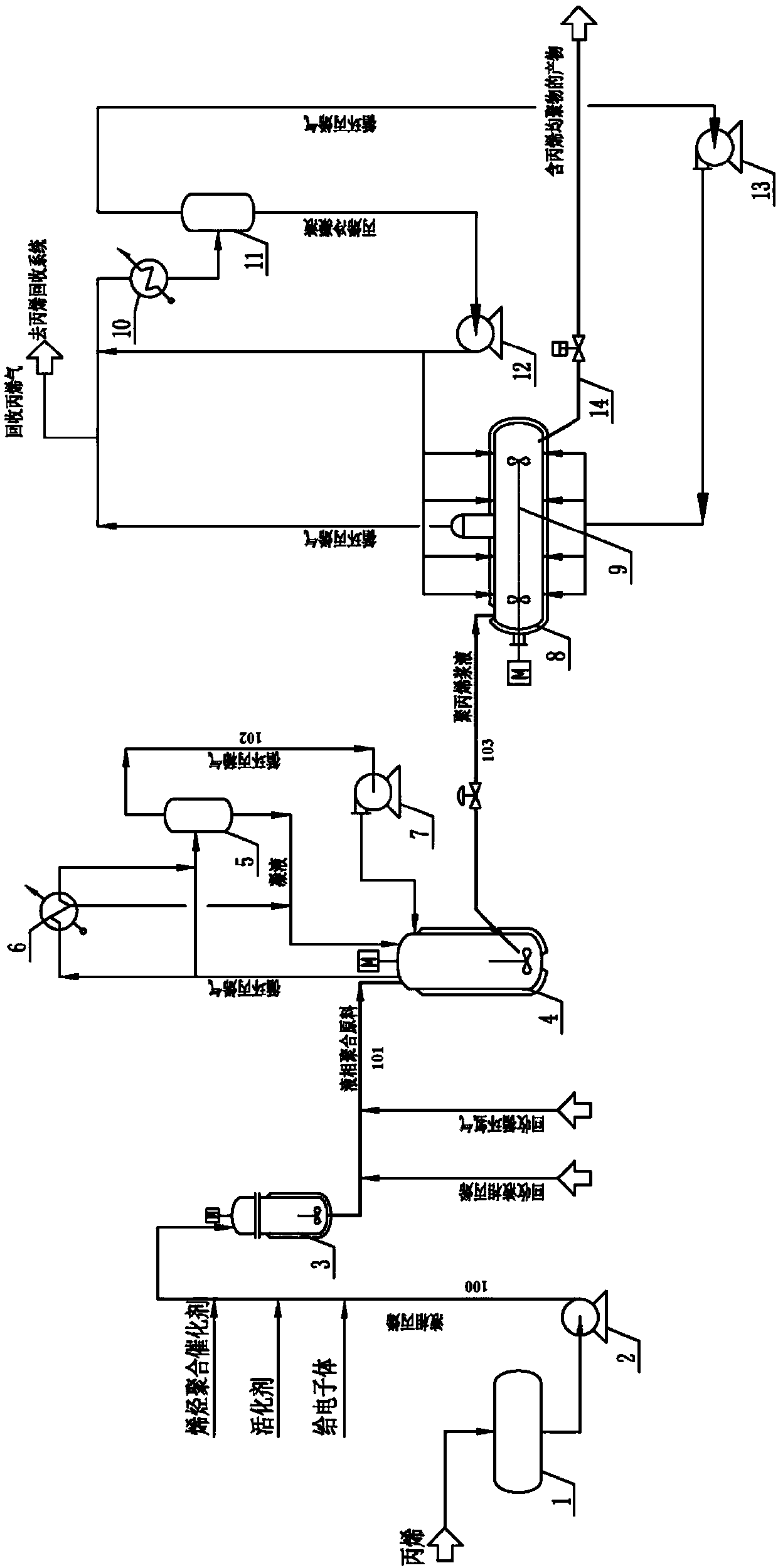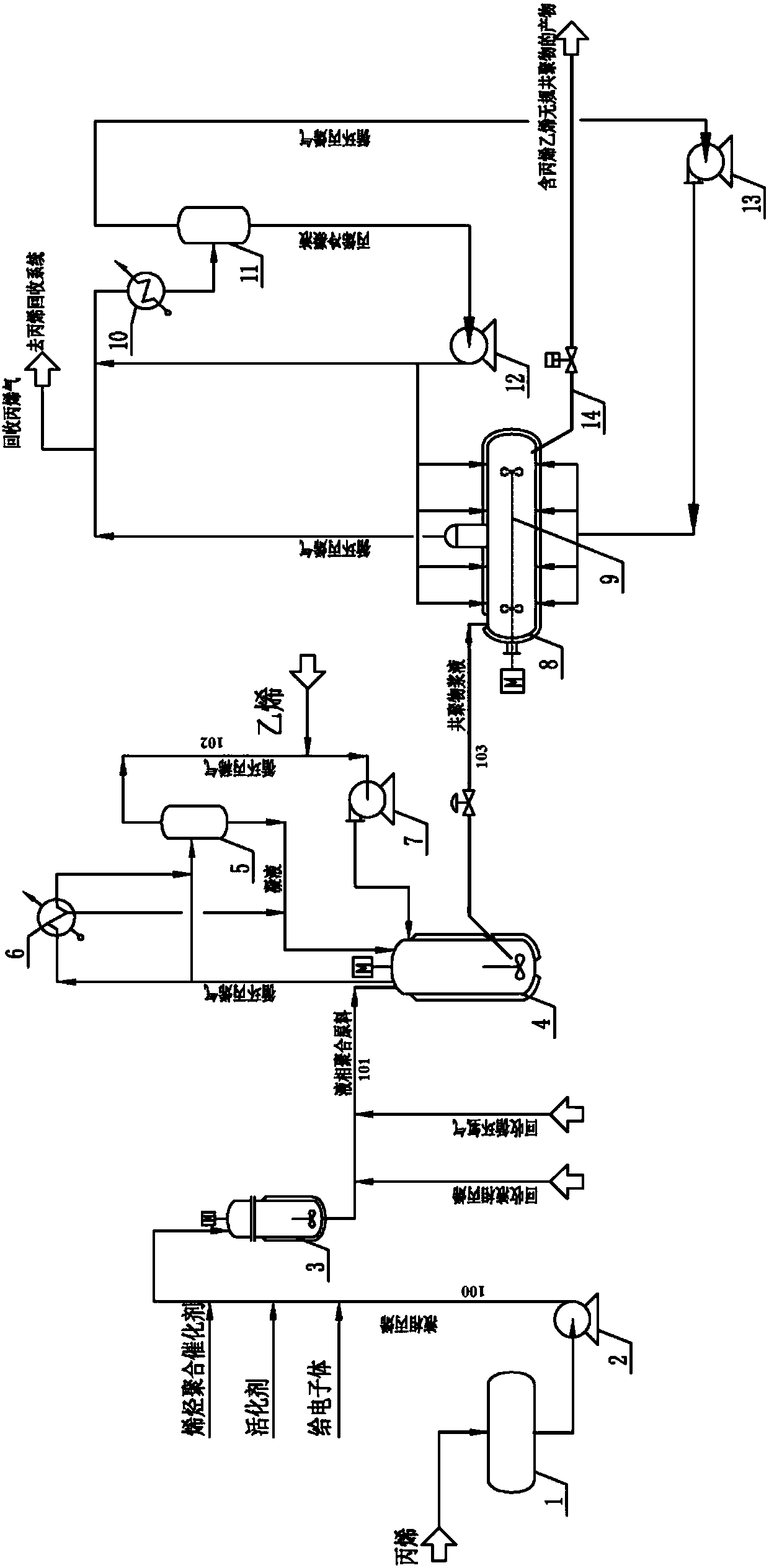Propylene homopolymerization or random copolymerization method
A technology of random copolymerization and propylene, which is applied in the field of propylene polymerization industrialization, can solve the problems of poor catalyst adaptability, low equipment efficiency, small device scale, etc., to reduce energy consumption per unit product, reduce usage and cost, and reduce plasticization Effect of Block Chance
- Summary
- Abstract
- Description
- Claims
- Application Information
AI Technical Summary
Problems solved by technology
Method used
Image
Examples
Embodiment 1
[0099] (1) Prepolymerization
[0100] Pressurize propylene to obtain liquid phase propylene with a pressure of about 4.2MPaG and a temperature of about 42°C; with liquid phase propylene as a carrier, Ti catalyst (CS-1) and 0.3 % by weight of triethylaluminum and 0.05% by weight of cyclohexylmethyldimethoxysilane; then all are directly input into the pre-polymerization tank to form a polymerization slurry, and then carried out at 42°C, 3.2MPaG, and a residence time of 4min Propylene pre-polymerization, the polymerization ratio of polypropylene in the obtained raw material slurry is 75 times;
[0101] (2) Liquid phase bulk polymerization
[0102] The raw material slurry obtained in (1) is added to recovery liquid phase propylene and hydrogen to form a liquid phase polymerization raw material (wherein the concentration of polypropylene is 200g / L, the recovery liquid phase propylene addition is about 25% by weight of the liquid phase propylene, and the hydrogen addition 0.08kg / 1...
Embodiment 2
[0110] (1) Prepolymerization
[0111]Propylene is pressurized to obtain liquid phase propylene with a pressure of about 4 MPaG and a temperature of about 45° C.; using liquid phase propylene as a carrier, adding Ti catalyst (CS-1) and 0.2 wt. % of triethylaluminum and 0.06% by weight of cyclohexylmethyldimethoxysilane; then all are directly input into the pre-polymerization tank to form a polymerization slurry, followed by propylene at 45°C, 3.6MPaG, and a residence time of 4min. Pre-polymerization, the polymerization ratio of polypropylene in the obtained raw material slurry is 50 times;
[0112] (2) Liquid phase bulk polymerization
[0113] The raw material slurry that (1) obtains is added reclaiming propylene and hydrogen to form liquid-phase polymerization raw material (wherein the concentration of polypropylene is 150g / L, reclaiming propylene add-on is about 27% by weight of liquid-phase propylene, and hydrogen add-on is 0.12kg / L 1000kg polypropylene), carry out liquid ...
Embodiment 3
[0121] (1) Prepolymerization
[0122] The propylene is pressurized to obtain liquid phase propylene with a pressure of about 4.5 MPaG and a temperature of about 40° C.; with the liquid phase propylene as a carrier, Ti catalyst (CS-1) and 0.4 % by weight of triethylaluminum and 0.04% by weight of cyclohexylmethyldimethoxysilane; then all are directly input into the prepolymerization tank to form a polymerization slurry, and then carried out at 40°C, 3.8MPaG, and a residence time of 5min Propylene pre-polymerization, the polymerization ratio of polypropylene in the obtained raw material slurry is 100 times;
[0123] (2) Liquid phase bulk polymerization
[0124] The raw material slurry that (1) obtains is added reclaiming propylene and hydrogen to mix liquid-phase polymerization raw material (wherein the concentration of polypropylene is 300g / L, and reclaiming propylene add-on is about 30% by weight of liquid-phase propylene, and hydrogen add-on is 0.2kg / L 1000kg polypropylene)...
PUM
| Property | Measurement | Unit |
|---|---|---|
| concentration | aaaaa | aaaaa |
Abstract
Description
Claims
Application Information
 Login to View More
Login to View More - R&D
- Intellectual Property
- Life Sciences
- Materials
- Tech Scout
- Unparalleled Data Quality
- Higher Quality Content
- 60% Fewer Hallucinations
Browse by: Latest US Patents, China's latest patents, Technical Efficacy Thesaurus, Application Domain, Technology Topic, Popular Technical Reports.
© 2025 PatSnap. All rights reserved.Legal|Privacy policy|Modern Slavery Act Transparency Statement|Sitemap|About US| Contact US: help@patsnap.com


